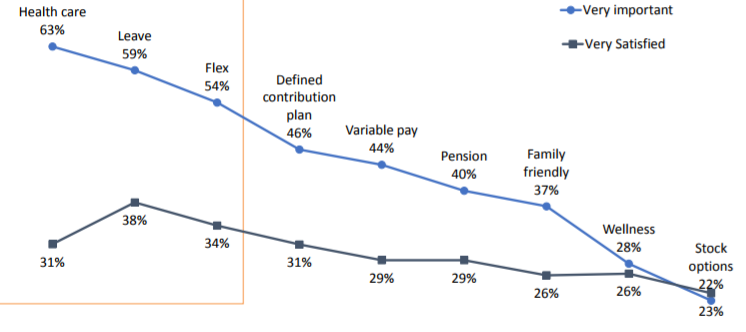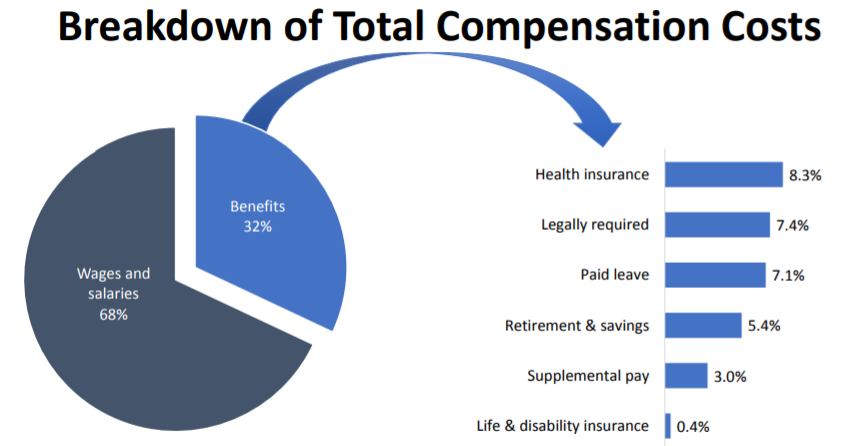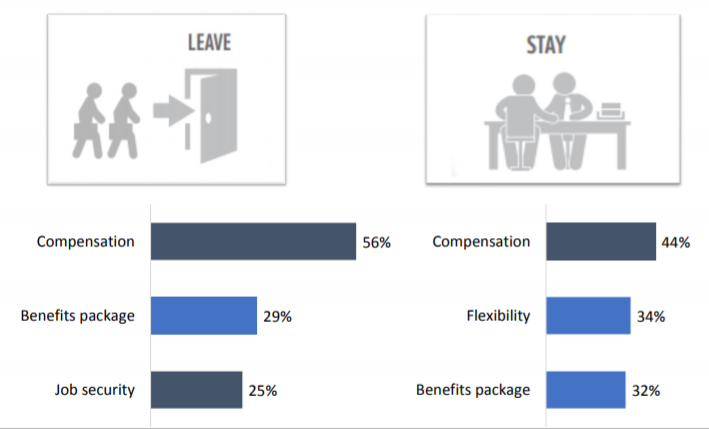Stay Competitive with Benefits or Risk Employee Flight
SHRM symposium shared tips on designing benefits programs to meet strategic objectives

Does your company offer the benefits that most employees want? If not, you may be wasting money and finding it hard to hire and retain valued employees.
"If you're there for your employees, they'll be there for you," said Shonna Waters, vice president of research at the Society for Human Resource Management (SHRM) at SHRM's Rewarding Work: Spotlight on Benefits Strategy symposium, held Aug. 7 in Cleveland.
Every employer should ask whether the cost of their benefits is money well-spent, she told the nearly 300 attendees.
Source: Bureau of Labor Statistics, Employer Costs for Employee Compensation (Dec. 2016). Click on graphic to view in a separate window.
A point to keep in mind: "Much of the media's coverage of employee benefits is dominated by Silicon Valley—the high-tech industries and the companies that are pushing the edge of benefits," Waters said. "We hear a lot in the news about organizations such as Netflix and Amazon that are offering extremely generous and even 'unlimited' parental leave policies, [but] the data actually shows that a minority of U.S. organizations are offering any paid maternity leave and even fewer are offering paid paternity leave."
Employers should keep their focus not necessarily on what the big, cutting-edge companies are doing "but what your peers are doing," she advised, because those are the employers with whom you're competing for talent.
Waters further cited SHRM's 2017 Employee Job Satisfaction and Engagement survey report, which showed that the top three benefits employees value are health care, leave and flexible work schedules. However, the report also pointed to large gaps between the percentage of employees who view these benefits as "very important" and the percentage that said they are "very satisfied" with that benefit.
Importance-Satisfaction Gap
| Benefit | Employees who view as "very important" | Employee who are "very satisfied" |
| Health care | 63% | 31% |
| Leave | 59% | 38% |
| Flexibility | 54% | 34% |

Source: Employee Job Satisfaction and Engagement survey report (SHRM, 2017). Cick on graphic to view in a separate window.
The findings point to the need to help employees better understand the value of their benefits package, as well as the need to evaluate whether the company has the right benefits offerings to begin with, Waters said. That requires understanding employee needs.
While only 4 percent of employers provide student loan repayment as a benefit, many younger employees have said they would prefer that their employers contribute to loan repayment first rather than to their 401(k) account, she pointed out.
Waters advised:
- Get smart about the competition. Review your benefits mix at least annually and use market data for comparison with your competitors' offerings.
- Take an employee-centered approach. Ask employees what benefits they value and whether they know about all their benefits offerings and how to use them, and note variations in how different demographic groups reply. Along with traditional employee surveys, use focus groups, stay interviews and social media polling. Let employees know that their responses will help in designing their benefits package.
People tend to support what they help to create, "so include them in the process," recommended Rosie Ward, CEO and co-founder of Minneapolis-based consultancy Salveo Partners, in another symposium presentation.
[SHRM members-only toolkit: Designing and Managing Flexible Benefits (Cafeteria) Plans]
Strategic Benefits Planning
"Spending on employee benefits accounts for the second to fifth largest expense for most organizations," said Stephen Ligus, vice president at Hylant, an insurance and risk management firm headquartered in Toledo, Ohio. Benefit spending by employers on health care alone over the past 10 years has grown on average 4.93 percent per year, he noted, citing Mercer's National Survey of Employer-Sponsored Health Plans. A typical large employer spent nearly $12,000 per employee on health care in 2016, up from $8,000 in 2007.
Ligus advised HR professionals to conduct a strategic benefits review every two to three years, leading to an action plan that keeps the benefits package competitive with peers and responsive to employee needs. The key steps are:
- Discovery. Identify business goals and ideal success factors around employee health, well-being and organizational culture. Hold stakeholder meetings with executives and employees, and analyze benefit usage data.
- Roadmap. Build a strategic plan using SMART (measurable, achievable, results-focused and time- bound) goals. Include appropriate vendor partnerships and create a timeline.
- Implementation. Put the strategy into practice with ongoing program maintenance.
- Stewardship. Evaluate and refine the plan over time, seeking stakeholder feedback.
How Employees View Their Benefits Can Keep Them Onboard or Drive Them Away The benefits that employees cite as keeping them on the job when viewed as valuable can differ from the benefits that, when viewed as insufficient, cause them to leave. Source: Employee Job Satisfaction and Engagement survey report (SHRM, 2017). |
Communication Tips
Karl Ahlrichs, SHRM-SCP, a consultant at Gregory & Appel in Indianapolis, also spoke to symposium attendees about communications challenges.
"Meet your employees where they are," he advised. Some prefer hearing about benefits by sitting together at meetings, while others want to watch a video presentation.
Optimize materials for viewing on a desktop computer and mobile devices, he said, and "if some want a benefit statement mailed to their home, then mail it to their home."
Create a benefits blog, allow comments and provide answers, he suggested. Create short, simple video reminders by using your smartphone: "Hey, Karl from benefits here. The open enrollment deadline is in five days, so click this link if you'd like to receive benefits next year.
"We're getting better at communication," he noted. "We're starting to figure this out."
A related SHRM symposium—Rewarding Work: Spotlight on Compensation & Performance Management, was held Aug. 8 in Cleveland. For highlights, see the SHRM Online article "Employers Try Better Ways to Measure and Reward Performance." |
Was this article useful? SHRM offers thousands of tools, templates and other exclusive member benefits, including compliance updates, sample policies, HR expert advice, education discounts, a growing online member community and much more. Join/Renew Now and let SHRM help you work smarter.
An organization run by AI is not a futuristic concept. Such technology is already a part of many workplaces and will continue to shape the labor market and HR. Here's how employers and employees can successfully manage generative AI and other AI-powered systems.





